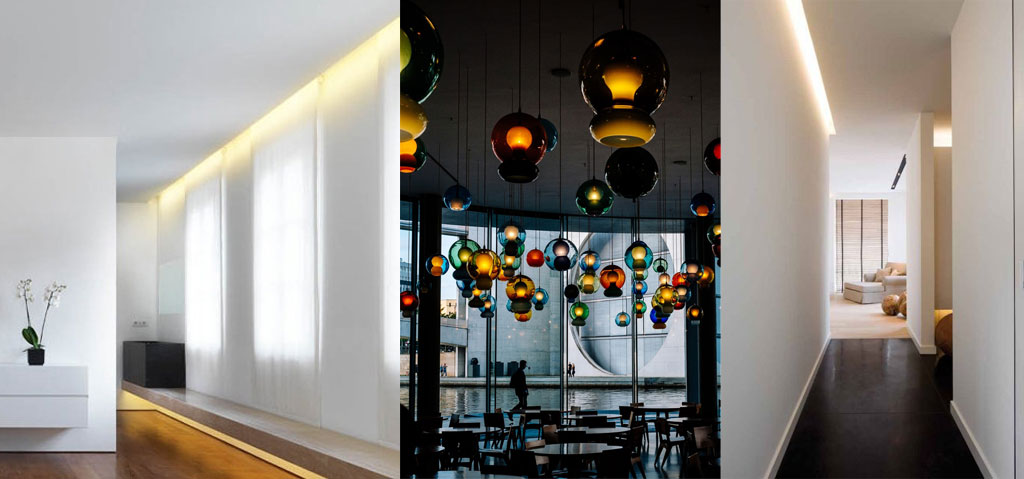

Light is a necessary medium through which we perceive the tangible world. “Lighting” is the application of light to spaces. The location of fixture, its intensity, the direction – each has a strong contribution towards creating a vision, visual comfort and perception. Not just light, but the lighting equipment itself can also affect impressions of the space and its owner. Lighting, therefore, can impact satisfaction, visibility, task performance, safety, security, sales, mood and atmosphere, aesthetic judgment and social interaction. Lighting helps create specific moods, tells a story, and also aid in diverting the focus on certain elements leaving some other in the background. It can transform a space by making it look exquisite or normal, high end or ordinary.
SOME OF THE FACTORS THAT PLAY CRUCIAL ROLES IN DETERMINING NECESSARY LIGHTING EFFECTS ARE:
Color perception: For an object to be perceived a certain color, that color must be present both in the object and the light striking it. Designers are concerned with color appearance or color rendering rather than the true color.
Focal point: As the human eye is naturally attracted to the brightest area in the field of view, by focusing a higher intensity of light on certain features in a space, we can make them focal points, directing attention to them, and establish a visual hierarchy.
Space perception :The type and pattern of light in a space can stimulate a psychological response. For example, bright uniform lighting, with light placed on walls and even the ceiling, can make a space appear public and visually larger in a lobby. The opposite of this can be done to have an inverse effect.
Modeling: Contrast of light and shadow creates 3D effects, reveals textures and depth to surfaces. For example, washing a brick wall with light will visually flatten its texture by reducing shadows, while grazing it at an angle will enrich its texture.
Image courtesy of Naomi J. Miller, FIES, FIALD, LC
THE TYPE OF LIGHT SOURCE :
– Point sources, such as incandescent lamps and LEDs, are small lamps that can produce pronounced shadows.
– Linear sources, such as fluorescent lamps, produce diffuse light output from the source’s surface, which softens shadows.
– Area sources are large surfaces that emit highly diffuse light, such as a ceiling reflecting light from an indirect light source.
SOME SPECIAL LIGHTING TECHNIQUES
Aside from the basic lighting layers, various techniques can be used to achieve specific lighting effects. These include down lighting, wall washing/grazing, cove lighting, up lighting, silhouetting and sparkle/glitter.
Down lighting: It is technique that places light below the light source and is available from a variety of lighting equipment, from down lights to recessed troffers. The light can be soft and diffuse for visual comfort in a space with critical visual tasks, or intense and non-diffuse to promote a visually stimulating atmosphere. Down lighting that isn’t balanced with other light can produce unwanted shadowing on faces.
Wall washing and grazing : Wall washing involves uniformly lighting a wall from top to bottom in a graded wash. This “washing” eliminates shadows, resulting in a smooth, visually flat appearance. It’s therefore best suited to flat walls.
Wall grazing is similar to wall washing, but the light source is placed closer to the wall, which accentuates shadows and thereby reveals texture. It’s therefore best suited to textured walls such as brick and stone. The light source can be placed at varying distances from the wall, changing the angle and thereby the amount of shadowing that is produced.
Cove lighting : Cove lighting involves illuminating perimeter coves. This highlights the architectural feature and sheds light on the ceiling, which is reflected into the space as indirect ambient light.
Uplighting : Uplighting places light above the light source. And it can be effective for certain applications, such table candlelight and highlighting architecture, plants and trees.
Silhouetting :Silhouetting involves backlighting an object with either no reduced frontal lighting or rendering it in silhouette. The backlight can be intense (which clarifies the object) or diffuse. This technique is typically used for illuminating artwork, branding or architecture for aesthetics.
Sparkle/Glitter: This is producing tiny points of glare for visual interest and to produce a sense of elegance. Examples include some chandeliers and sparkle on restaurant silverware.